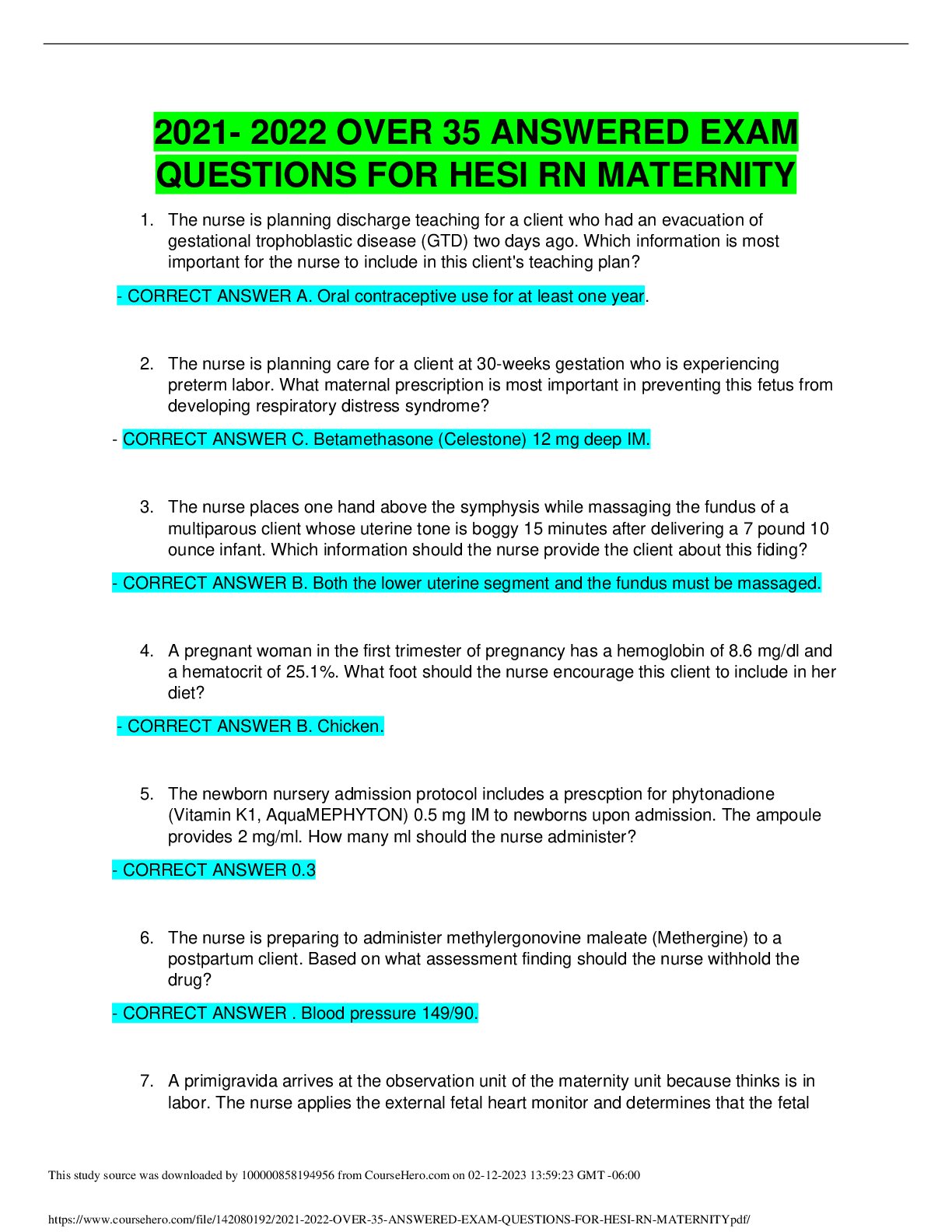Psychology > QUESTIONS & ANSWERS > WGU C180 Intro to Psychology, Exam Questions and answers, 100% Accurate, graded A+ (All)
WGU C180 Intro to Psychology, Exam Questions and answers, 100% Accurate, graded A+
Document Content and Description Below
WGU C180 Intro to Psychology, Exam Questions and answers, 100% Accurate, graded A+ Structuralism Wilhelm Wundt Functionalism William James Psychodynamic Sigmund Freud Behaviorism John B. W... atson and B. F. Skinner Gestalt Max Wertheimer Humanistic Abraham Maslow and Carl Rogers Key mental strategies and goals are inborn through adaptation of the species, the result of natural selection. Evolutionary Psychology Uses computer as a model for the human mind. Cognitive Psychology Belief that people have positive values, free will, and deep inner creativity; inspired the positive psychology movement. Humanistic "The whole is more than the sum of its parts." Gestalt Behavior is the appropriate focus of psychology. Behaviorism Conflicts among conscious and unconscious forces underlie many thoughts, feelings, and behaviors. Psychodynamic Studies why thoughts, feelings, and behavior occur and how they are adaptive. Functionalism Uses introspection to discover the elements of the mind and rules for combining them. Structuralism The goal of this type of research is to conduct observations, examinations, and then a description. Descriptive The goal of this type of research is to study the relationship of two or more variables Correlational Research The goal of this type of research is to conduct controlled situations in which the researcher observes how one variable may cause changes in another Experimental Research A researcher goes, observes, and records behavior in it's natural setting Naturalistic Observation A researcher focuses on a single participant and examines that person in great detail Case Study A researcher asks people a set of questions to determine their thoughts, feelings, or behaviors Survey The variable that the researcher manipulates Independent Variable The variable that the researcher measures Dependent Variable The group that receives the complete procedure that defines the experiment Experimental Group A group that is treated exactly the same way as the experimental group, except that the independent variable is not manipulated Control Group Assigning participants randomly to experimental and control groups so that the two groups are similar Random Assignment Receive signals from axons and other neurons Dendrites Release chemicals into the spaces between neurons when activated by their neuron Terminal Buttons A long, cable-like structure that send signals to other neurons, muscles, or organs Axon The place between two neurons where sending and receiving signals take place Synapse The central part of the neuron; it contains the nucleus Cell Body Protects the cell body Cell Membrane An insulating layer around the axon that helps electrical impulses transmit quickly Myelin The lobes at the back of the head concerned entirely with vision Occipital Lobes The lobes under the temples that process sound, work on memory, and comprehend language Temporal Lobes The lobes at the top rear of the brain, involved in attention, arithmetic, touch, and registering special location Parietal Lobes The lobes located behind the forehead, involved in planning, memory search, motor control, speech control, reasoning, and emotions Frontal Lobes At the base of the brain and manages balance and coordination Cerebellum Plays a key role in allowing new information into your brain's memory banks Hippocampus Relays impulses, especially sensory impulses, to and from the cerebral cortex Thalamus Plays a role in controlling eating, drinking; and regulating body temperature, blood pressure, heart rate, sexual behavior, and hormones Hypothalamus Relays information to the spinal cord Brainstem Plays a role in strong emotions such as fear and anger Amygdala A similar but nonidentical stimulus elicits the conditioned response Stimulus Generalization Achieved by repeatedly presenting the conditioned stimulus without the unconditioned stimulus Extinction Automatic response elicited by the unconditioned stimulus Unconditioned Response A stimulus that elicits an automatic response not dependent on prior learning Unconditioned Stimulus An originally neutral stimulus that comes to produce a response evoked by an unconditioned stimulus after it has been paired enough times with that unconditioned stimulus. Conditioned Stimulus A response that depends (is conditional) on pairing the conditioned stimulus with an unconditioned stimulus; once learned, the response to the unconditioned stimulus now occurs when the conditioned stimulus is presented alone. Conditioned Response Miss Jane's 3rd grade class did very well on their end-of-year exams, so she threw them a pizza party. Positive Reinforcement If Jack's factory employees meet their production goal, he reduces their work hours for the final week of the month. Negative Reinforcement Amy speeds through a construction zone, and is pulled over and given a ticket by a police officer. Positive Punishment Joe came home after his curfew three times in a row, so his parents took away his access to his car for one month. Negative Punishment Memories that can be voluntarily accessed Explicit Memory A type of explicit memory - it is personal memories of the past Episodic Memory A type of explicit memory - it is memories for the meaning of words, concepts, or facts about the world Semantic Memory Memories that are unconscious and cannot be voluntarily accessed; include habits and skills Implicit Memory Ages 0-1: mouth (sucking and biting), successful weaning from mother's breast or bottle Oral Stage Ages 1-3: anus (retaining and expelling feces) successful toilet training Anal Stage Ages 3-6: clitoris or penis, successful identification with same-sex parent Phallic Stage Ages 6-puberty: no particular locus of pleasure, sexual impulses are repressed; successful transformation of repressed sexual urges into socially acceptable activities Latency Stage Puberty and onward: vagina or penis; successful formation of mature sexual love relationship Genital Stage Marge tends to be depressed and self-conscious, and often anxious High in Neuroticism (also called emotionality) Jess excels at organization and can be relied on to make sure she gets the job done well and on time. High in Conscientiousness (also called dependability) Mark is gregarious, assertive, and likes exciting activities with others High in Extraversion (also called sociability) Anna is imaginative, creative, and enjoys trying new things High in Openness Greg is seen as very trustworthy, and always kind and helpful to others High in Agreeableness A belief or a set of beliefs about people from a particular category (e.g., race, sex, religion). Stereotype An attitude that is generally negative toward members of a group. Prejudice A negative behavior toward individuals from a specific group that arises from unjustified negative attitudes about that group. Discrimination The strong tendency to interpret other people's behavior (disposition) as arising from internal causes rather than external ones (situation). Fundamental Attribution Error The inclination to attribute your own failures to external causes and your successes to internal ones, but to attribute other people's failures to internal causes and their successes to external causes. Self-Serving Bias The assumption that people get what they deserve. Belief in a just world Adults seek closeness and interdependence in relationships and are not worried about possibly losing the relationship because they feel secure in it. Secure Attachment Style Adults are uncomfortable with intimacy and closeness. Avoidant Attachment Style Adults want but simultaneously fear a relationship. Anxious-Ambivalent Attachment Style The tendency of group members' opinions to become more extreme (in the same direction as their initial opinions) after group discussion. Group Polarization The group process that arises when people who try to solve problems together accept on another's information and ideas without subjecting them to critical analysis. Groupthink Occurs when some members don't contribute as much to a shared group task as do others and instead let other members work proportionally harder. Social Loafing The increase in performance that can occur simply as a result of being part of a group or in the presence of other people. Social Facilitation The motivation to increase another person's welfare. Altruism The tendency for people not to offer help in an emergency; the more bystanders, the less likely any one of them will volunteer help. Bystander Effect An exaggerated, irrational fear of a specific object, activity, or situation that leads the person to go to extreme lengths to avoid the feared stimulus. Phobia Fear or avoid places that might be difficult to leave should panic symptoms occur. Agoraphobia Fear of public embarrassment or humiliation, which leads the person to avoid situations likely to arouse this fear. Social Anxiety Disorder/Social Phobia Presence of recurrent and consistent thoughts, impulses, or images that feel intrusive and inappropriate and that are difficult to suppress or ignore. Obsessive-Compulsive Disorder After experiencing a traumatic event, persistent intrusive symptoms, avoidance of stimuli associated with the trauma, negative changes in thoughts and mood, and heightened arousal and activity - all lasting longer than one month. Post-Traumatic Stress Disorder Excessive anxiety and worry that is not consistently related to a specific object or situation. Generalized Anxiety Disorder Frequent, unexpected panic attacks or fear and avoidance of such attacks. Panic Disorder A pattern of suspicion and distrust of oth [Show More]
Last updated: 2 years ago
Preview 1 out of 14 pages
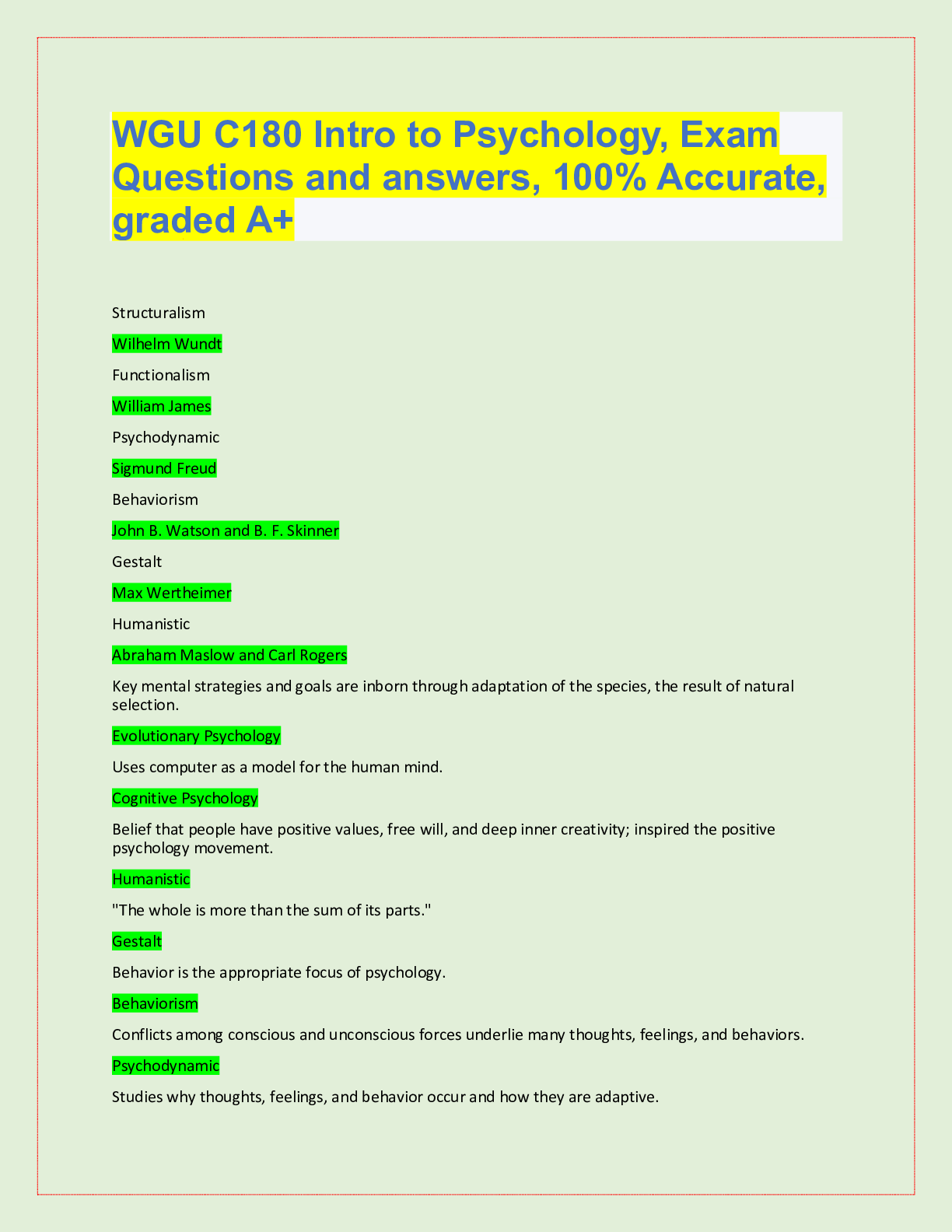
Buy this document to get the full access instantly
Instant Download Access after purchase
Buy NowInstant download
We Accept:

Also available in bundle (1)

WGU C180 BUNDLE. VERIFIED
WGU C180 Units, Top Exam Questions and answers, 100% Accurate, graded A+
By Topmark 2 years ago
$30
13
Reviews( 0 )
$9.00
Can't find what you want? Try our AI powered Search
Document information
Connected school, study & course
About the document
Uploaded On
Mar 13, 2023
Number of pages
14
Written in
Additional information
This document has been written for:
Uploaded
Mar 13, 2023
Downloads
0
Views
120

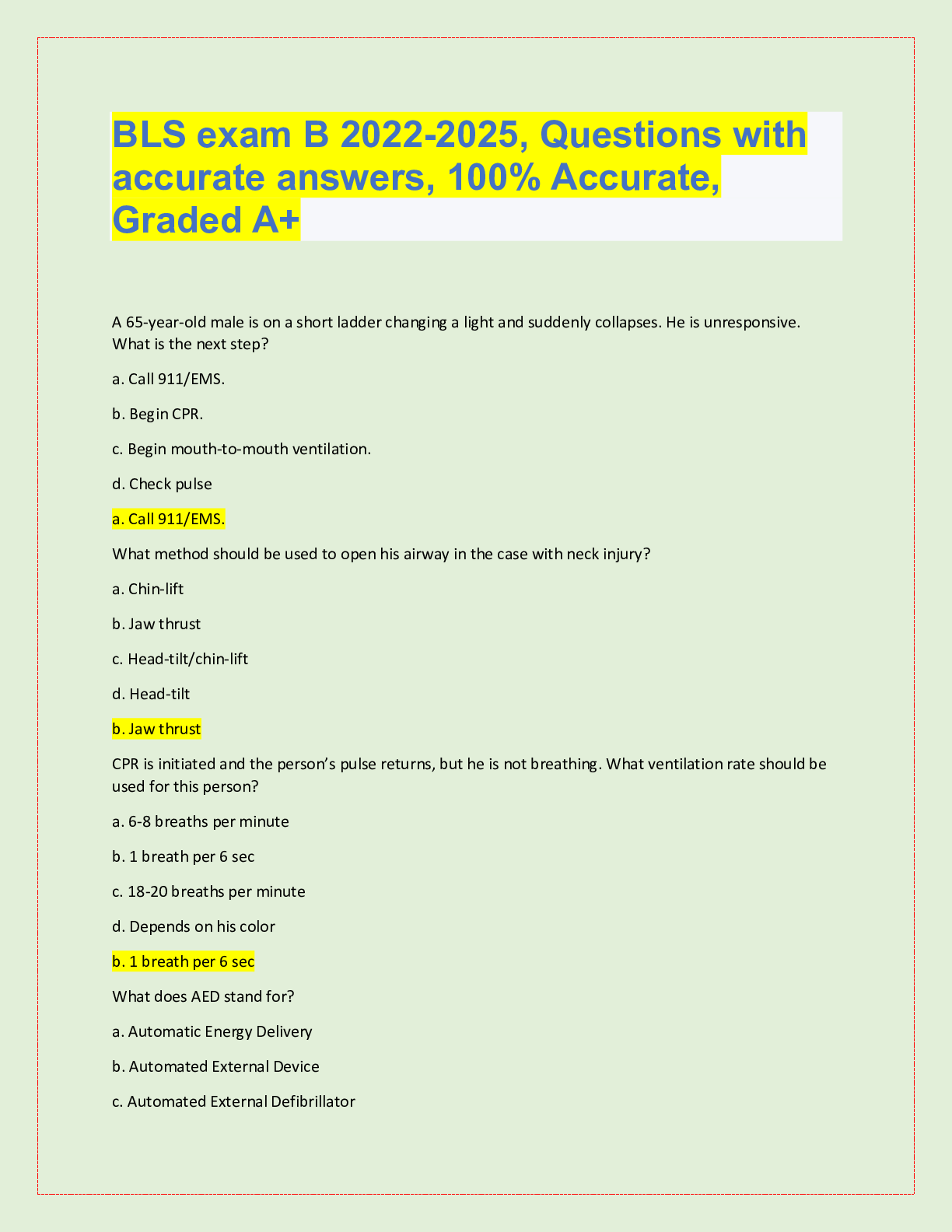











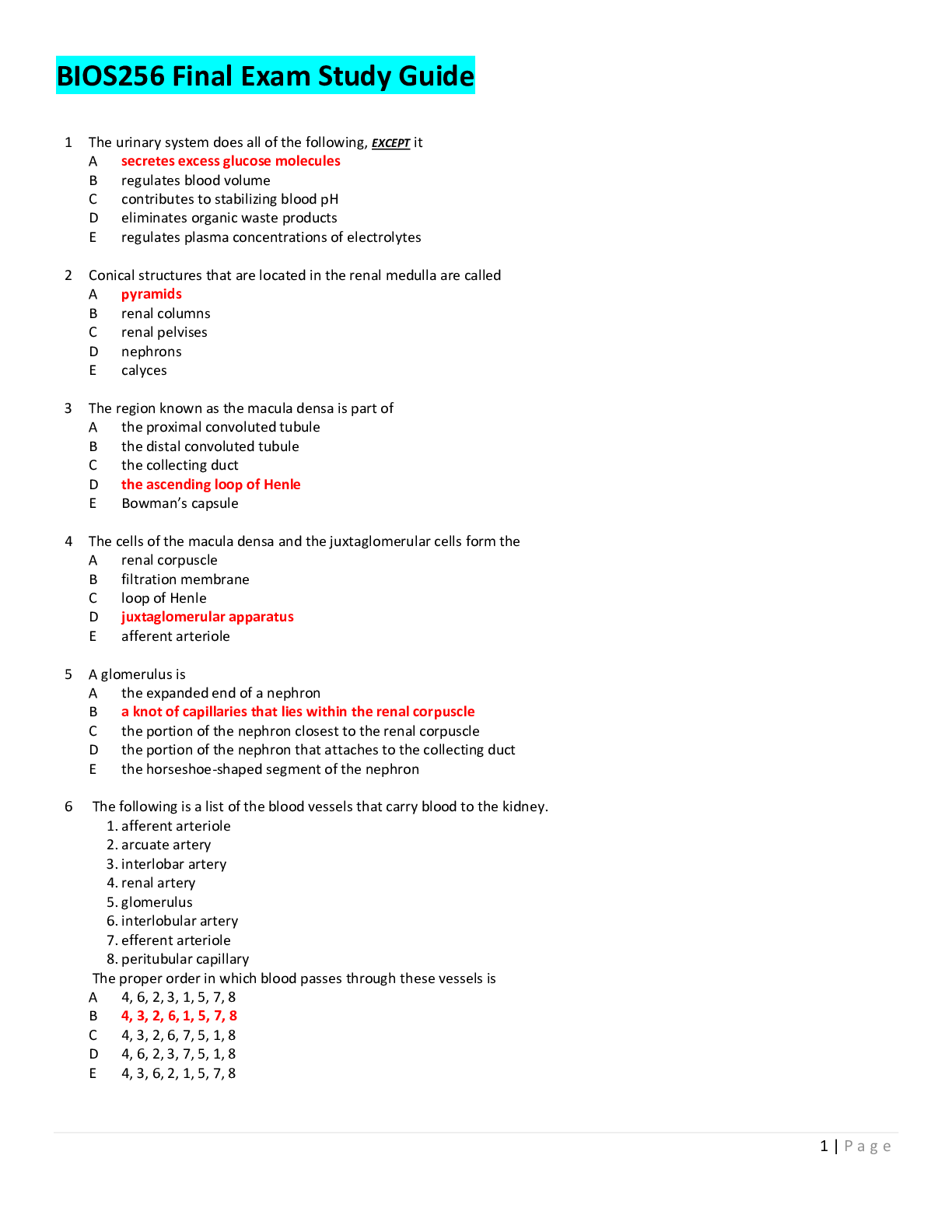
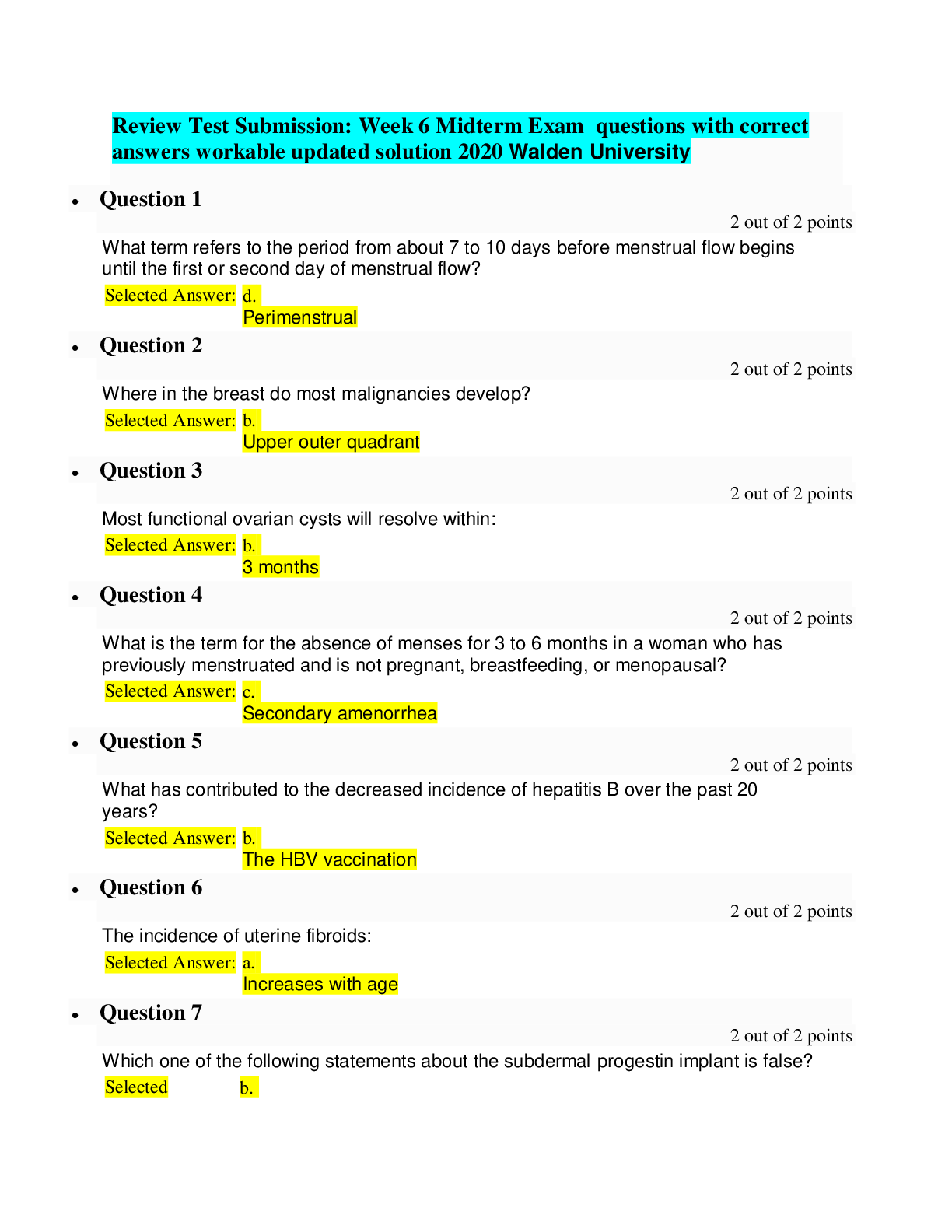

.png)




